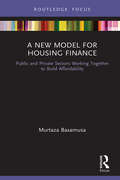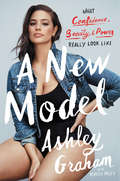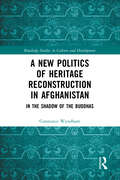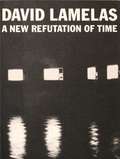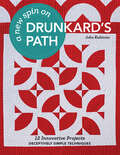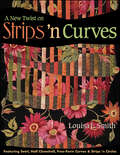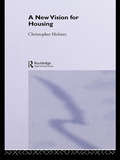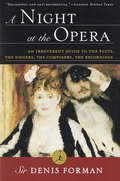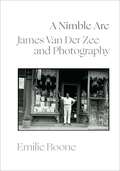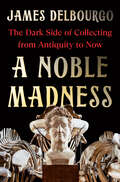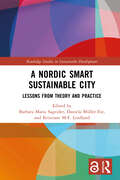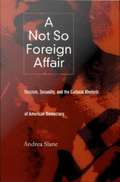- Table View
- List View
A New Model for Housing Finance: Public and Private Sectors Working Together to Build Affordability
by Murtaza BaxamusaA New Model for Housing Finance presents a thought-provoking solution to the housing crisis that follows the division of public and private money on housing costs and benefits. It brings a practical perspective on why housing is unaffordable, and what can be done about it using public and private capital. This book re-examines the foundation of housing finance in the United States with the aim to shift the paradigm from the public and private sectors working in silos, to working together. Through brief yet rigorous chapters, the book assesses the policy failures of both public and private sectors by drawing attention to the continuing human impacts of this man-made crisis, finally calling for a new model of financing housing through public–private partnerships. The limited impact and false hope of planning interventions, as well as the widespread economic impacts of the global pandemic of 2020, demonstrate the urgent need for change in our approach to housing policy, and this book lays out a path forward. It will be of interest to anyone working in or studying housing, social justice, urban planning, urban studies, and public policy.
A New Model: What Confidence, Beauty, & Power Really Look Like
by Rebecca Paley Ashley Graham“Graham’s honest new book chronicles the making of a body-positive icon . . . the story behind the success story. Often charming and inspirational.” —VogueVoluptuous beauty Ashley Graham has been modeling professionally since the age of thirteen. Discovered at a shopping mall in Nebraska, her stunning face and sexy curves have graced the covers of top magazines, including Cosmopolitan and British Vogue, and she was the first size 14 model to appear on the front of the wildly popular Sports Illustrated swimsuit issue. The face of brands such as H&M Studio, she is also a judge for the latest season of America’s Next Top Model. And that’s only the beginning for this extraordinary talent.A woman who proves that when it comes to beauty, size is just a number, Ashley is the voice for the body positivity movement today and a role model for all women—no matter their individual body type, shape, or weight.In this collection of insightful, provocative essays illustrated with a dozen photos, Ashley shares her perspective on how ideas around body image are evolving—and how we still have work to do; the fun—and stress—of a career in the fashion world; her life before modeling; and her path to accepting her size without limiting her dreams—defying rigid industry standards and naysayers who told her it couldn’t be done. As she talks about her successes and setbacks, Ashley offers support for every woman coming to terms with who she is, bolsters her self-confidence, and motivates her to be her strongest, healthiest, and most beautiful self.“Evocative.” —The Cut“Positive, understanding, and uplifting.” —Booklist
A New Politics of Heritage Reconstruction in Afghanistan: In the Shadow of the Buddhas (Routledge Studies in Culture and Development)
by Constance WyndhamA New Politics of Heritage Reconstruction in Afghanistan investigates the politics of cultural heritage preservation in Afghanistan between 2008 and 2015. Based on several periods of ethnographic fieldwork and the author’s direct employment on several internationally-sponsored heritage projects, this book studies the new and complex intersections between cultural heritage and politics in Afghanistan. Wyndham argues that a particular configuration of heritage and politics has emerged after the destruction of the Buddhas at Bamyan and demonstrates how the characteristics of this ‘post-Bamyan’ heritage paradigm are revealed through a number of case studies of internationally sponsored heritage work. These case studies reveal how politics and heritage are currently configured across a diverse range of governments, state and non-state actors, NGOs, individuals and forms of expertise—and why such intersections matter. The book responds to a call from across the discipline of Heritage Studies to look more closely at the relationships between heritage, power and politics. A New Politics of Heritage Reconstruction in Afghanistan provides a fascinating case study on the intersection of heritage and politics that will be of interest to students and scholars of heritage, as well as to professionals working on heritage preservation - both within and outside of government.
A New Refutation of Time
by David LamelasInitially published in print in collaboration with the Kunstverein München, Munich and Richter Verlag, Dusseldorf. Introduction by Bartomeu Marí, Dirk Snauwaert. Texts by Heike Ander, "Works 1964-1976;" Benjamin H.D. Buchloh, "Structure, Sign and Reference in the Work of David Lamelas;" David Lamelas and Raúl Escari, "Self Awareness;" Lynda Morris, "Interview with David Lamelas, London, December 1972?
A New Role for Museum Educators: Purpose, Approach, and Mindset
by Elizabeth WoodA New Role for Museum Educators shows how learning happens in communities, how volunteers and professionals approach their work, the underlying principles and philosophies that guide the work of museum education, and how these practices are always evolving to remain relevant. Museum education in its most expansive definition is about communicating messages, creating learning experiences, and, at its most aspirational, promoting human development for people of all backgrounds, abilities, and circumstances. This edited volume revisits the legacy of museum education practices, reflecting on the changing context of community and the role of cultural institutions, and provides insights into new directions that museums can take with a visitor-centered mindset. It provides foundational concepts around educational philosophies that guide practice, applied methods and approaches for implementation, and the ethos of an educational institution intended to support community learning and engagement that are essential to provide for the wide-ranging needs of all audiences. International perspectives from a variety of museums are considered, including art museums, children’s museums, history museums and historic sites, science museums, botanical gardens, zoos, and aquariums. Chapters include thought-provoking reflections on contemporary practices, concrete examples from across the globe, and useful tools for anyone working with public audiences. Grounded in practice and informed by research, this volume will be a go-to resource for arts and cultural organization practitioners, particularly those working in Museum Education. It will also be essential reading for students of Museum Studies, Education, and related fields
A New Spin on Drunkard's Path: 12 Innovative Projects—Deceptively Simple Techniques
by John Kubiniec“John Kubiniec’s aim is to take the fear and mystery out of creating with curves, and has put together enough intriguing designs to tempt any quilter.” —Down Under QuiltsShake up the Drunkard’s Path block with quilting teacher John Kubiniec. Go beyond the basics of curved piecing with twelve innovative projects based on a classic pattern. Discover how sewing pre-pieced units like rail fences, half-square triangles, and sixteen-patches can completely change up the Drunkard’s Path look. Take it a step further with creative sashings and add-ons to alter the finished layout. The end result looks complex but is actually easy to sew!“The instructions are foolproof. It is amazing the variety you can create when you start to experiment—these twelve designs are all different and should keep any quilter happy for months. This is a book to ignite your creative imagination.” —yarnsandfabrics.co.uk“Many quilters avoid curved piecing, but the projects in this book will make you want to try—and buy in! The quilts look very complicated, but John breaks down the steps to make it easy, and painless.” —Quilter’s Connection“A new take on curved piecing. Go beyond the basics with twelve innovative projects based on a classic pattern.” —Today’s Quilter
A New Twist on Strips 'n Curves: Featuring Swirl, Half Clamshell, Free-Form Curves & Strips 'n Circles
by Louisa L. SmithStrip Piecing With Twists and Turns! • Start with basic strip piecing, add easy and gently curved edges, and prepare to be amazed! • Louisa introduces 4 design concepts, 2 template based and 2 template free, all with step-by-step instructions Whether you own Louisa’s 2001 best-selling Strips ‘n Curves or you’re new to the world of combining curved-edge and strip piecing, you’ll love the fresh ideas and fabulous inspiration in this book. Learn Louisa’s four new techniques (Half Clamshell, Free-Form Curves, Strips ‘n Circles, and The Swirl); then try them in four complete project quilts! Lots of step-bystep photos and clear instructions ensure your success. Ideas for home décor, garments, and quilts, quilts, quilts! *Important Note about PRINT ON DEMAND Editions: This title will be printed after purchase and will arrive separately from any in-stock items. Please allow approximately 2 weeks for USA delivery, with an additional 2 weeks for international shipments. Expedited shipping is not available on POD Editions. The printing quality in this copy will vary from the original offset printing edition and may look more saturated due to printing on demand by a high-quality printer on uncoated (non-glossy) paper. The information presented in this version is the same as the most recent printed edition. Any pattern pullouts have been separated and presented as single pages.
A New Vision for Housing
by Christopher HolmesIn 1945 the Labour Government set out to enable everyone to have a decent home, where people from all walks of life could live together. This dream was destroyed by a succession of avoidable mistakes and almost everyone now seems to believe that it is impossible to rediscover that vision. This book challenges that fatalism, tracing the policy mistakes that have given rise to this inequitable state from the folly of mass housing to the unfair tax privileges of many home owners. Holmes describes and advocates a new vision for the new millennium, finding solutions variously in development, planning, economic structures, social reform, and political reassessment to narrow the gap between rich and poor and enable people in all housing tenures to finally have a choice.
A Night at the Opera: An Irreverent Guide to The Plots, The Singers, The Composers, The Recordings
by Denis FormanThis slightly irreverent guide to opera summarizes the plots of 17 of the world's great operas, including Aida, La Boheme, and Carmen, and describes their characters, artists, and composers.
A Nimble Arc: James Van Der Zee and Photography (The Visual Arts of Africa and its Diasporas)
by Emilie BooneWhile James Van Der Zee is widely known and praised for his studio portraits from the Harlem Renaissance era, much of the diversity and expansive reach of his work has been overlooked. From the major role his studio played for decades photographing ordinary people and events in the Harlem community to the inclusion of his photographs in the landmark Harlem on My Mind exhibition at the Metropolitan Museum of Art in 1969, Van Der Zee was a foundational Black photographer whose work illustrates the shifting ways photography serves as a constitutive force within Black life. In A Nimble Arc, Emilie Boone considers Van Der Zee’s photographic work over the course of the twentieth century, showing how it foregrounded aspects of Black daily life in the United States and in the larger African diaspora. Boone argues that Van Der Zee’s work exists at the crossroads of art and the vernacular, challenging the distinction between canonical art photographs and the kind of output common to commercial photography studios. Boone’s account recasts our understanding not only of this celebrated figure but of photography within the arc of quotidian Black life.
A Noble Madness: The Dark Side of Collecting from Antiquity to Now
by James Delbourgo"In this fascinating, witty, and provocative book, Delbourgo’s collectors range from emperors to scientists, from shopaholics to taxonomists, from bibliomaniacs to serial killers. Give it to the collector in your life, and watch the sparks fly!"—Cathy Gere, author of The Tomb of Agamemnon A captivating history of obsessive collectors: from ancient looters and idolaters to fin de siècle decadents, Freudian psychos, and hoarders. Collectors are often praised for their taste in art or contributions to science, and considered great public benefactors. But collectors have also been seen as dangerous obsessives who love objects too much. Why? From looters and idolaters to fin de siècle decadents and Freudian psychos, A Noble Madness is a captivating history of obsessive collectors from ancient times to today. From Roman emperors lusting after statues to modern-day hoarders, award-winning author James Delbourgo tells the extraordinary story of fanatical collectors throughout history. He explains how the idea first emerged that when we look at someone’s collection, we see a portrait of their soul: complex, intriguing, yet possibly insane. What Delbourgo calls "the Romantic collecting self" has always lurked on the dark side of humanity. But this dark side has a silver lining. Because obsessive collectors are driven by passion, not profit, they have been countercultural heroes in the modern imagination, defying respectability and taste in the name of truth to self. A grand portrait gallery of collectors in all their decadent glory, A Noble Madness recounts the saga of the human urge to accumulate, from Caligula to Marie Antoinette, Balzac to Freud, Norman Bates to Andy Warhol. Collectors’ love of objects may be mad, even dangerous. But we want to believe their love’s a noble madness because by expressing that love, they are themselves.
A Nordic Smart Sustainable City: Lessons from Theory and Practice (Routledge Studies in Sustainable Development)
by Barbara Maria SageidetThis book critically explores research and development on the smart sustainable city, emphasizing the tension and association between smartness and sustainability, both as a concept and as a phenomenon in a Nordic context.Worldwide, increasing urbanization and its related challenges, along with urgent environmental issues, have sped up the international interest for smart, sustainable cities as a concept that could increase the efficiency of services, minimize environmental impacts, and improve the quality of living in cities and urban areas. This book scientifically discusses the provenance, substance, and processes of the smart sustainable city, with illustrative examples of how it is translated into urban realities in a medium-sized city, drawing upon Stavanger, one of the first, and one of the leading smart sustainable cities in Europe. The book’s multidisciplinary perspectives and thematic lenses include education and knowledge, arts and culture, safety, climate and sustainability, mobility and transport, economics, democracy, participation, innovation and entrepreneurship, data, and communication. While demonstrating the academic breadth and wide-ranging impact of the smart sustainable city concept, the book promotes and updates the ground for mutual understanding, communication, and collaboration between multiple disciplines and stakeholders involved in developing functional, democratic, and sustainable solutions for the urban present and future.A Nordic Smart Sustainable City: Lessons from Theory and Practice presents an overview of scientific and practical current approaches in a readable format for practitioners and administrators in municipalities and related businesses, for researchers, academics, educators, students, and stakeholders.
A Not So Foreign Affair: Fascism, Sexuality, and the Cultural Rhetoric of American Democracy
by Andrea SlaneIn A Not So Foreign Affair Andrea Slane investigates the influence of images of Nazism on debates about sexuality that are central to contemporary American political rhetoric. By analyzing an array of films, journalism, scholarly theories, melodrama, video, and propaganda literature, Slane describes a common rhetoric that emerged during the 1930s and 1940s as a means of distinguishing "democratic sexuality" from that ascribed to Nazi Germany. World War II marked a turning point in the cultural rhetoric of democracy, Slane claims, because it intensified a preoccupation with the political role of private life and pushed sexuality to the center of democratic discourse. Having created tremendous anxiety--and fascination--in American culture, Nazism became associated with promiscuity, sexual perversionand the destruction of the family. Slane reveals how this particular imprint of fascism is used in progressive as well as conservative imagery and language to further their domestic agendas and shows how our cultural engagement with Nazism reflects the inherent tension in democracy between the value of diversity, individual freedoms national identity, and notions of the common good. Finally, she applies her analysis of wartime narratives to contemporary texts, examining anti-abortion, anti-gay, and anti-federal rhetoric, as well as the psychic life of skinheads, censorship debates, and the contemporary fascination with incest. An invaluable resource for understanding the language we use--both visual and narrative--to describe and debate democracy in the United States today, A Not So Foreign Affair will appeal to those interested in cultural studies, film and video studies, American studies, twentieth century history, German studies, rhetoric, and sexuality studies.
A Not Too Greatly Changed Eden: The Story of the Philosophers’ Camp in the Adirondacks
by James SchlettIn August 1858, William James Stillman, a painter and founding editor of the acclaimed but short-lived art journal The Crayon, organized a camping expedition for some of America's preeminent intellectuals to Follensby Pond in the Adirondacks. Dubbed the "Philosophers' Camp," the trip included the Swiss American scientist and Harvard College professor Jean Louis Rodolphe Agassiz, the Republican lawyer and future U.S. attorney general Ebenezer Rockwood Hoar, the Cambridge poet James Russell Lowell, and the transcendental philosopher Ralph Waldo Emerson, who would later pen a poem about the experience. News that these cultured men were living like "Sacs and Sioux" in the wilderness appeared in newspapers across the nation and helped fuel a widespread interest in exploring the Adirondacks. In this book, James Schlett recounts the story of the Philosophers' Camp, from the lives and careers of--and friendships and frictions among--the participants to the extensive preparations for the expedition and the several-day encampment to its lasting legacy. Schlett's account is a sweeping tale that provides vistas of the dramatically changing landscapes of the United States in the second half of the nineteenth century. As he relates, the scholars later formed an Adirondack Club that set out to establish a permanent encampment at nearby Ampersand Pond. Their plans, however, were dashed amid the outbreak of the Civil War and the advancement of civilization into a wilderness that Stillman described as "a not too greatly changed Eden." But the Adirondacks were indeed changing. When Stillman returned to the site of the Philosophers' Camp in 1884, he found the woods around Follensby had been disfigured by tourists. Development, industrialization, and commercialization had transformed the Adirondack wilderness as they would nearly every other aspect of the American landscape. Such devastation would later inspire conservationists to establish Adirondack Park in 1892. At the close of the book, Schlett looks at the preservation of Follensby Pond, now protected by the Nature Conservancy, and the camp site's potential integration into the Adirondack Forest Preserve.
A Paradise Lost: The Imperial Garden Yuanming Yuan (China Academic Library)
by Young-Tsu WongThis book is aimed at readers and researchers who are interested in Chinese garden architecture, the rise and fall of Yuanming Yuan and the history of the Qing dynasty. It is the first comprehensive study of the palatial garden complex in a Western language, and is amply illustrated with photographs and original drawings. Wong Young-tsu's engaging writing style brings 'the garden of perfect brightness' to life as he leads readers on a grand tour of its architecture and history.
A Paradise of Small Houses: The Evolution, Devolution, and Potential Rebirth of Urban Housing
by Max PodemskiFrom the Haitian-style &“shotgun&” houses of the 19th century to the lavish high-rises of the 21st century, a walk through the streets of America&’s neighborhoods that reveals the rich history—and future—of urban housingThe Philadelphia row house. The New York tenement. The Boston triple-decker. Every American city has its own iconic housing style, structures that have been home to generations of families and are symbols of identity and pride. Max Podemski, an urban planner for the city of Los Angeles and lifelong architecture buff, has spent his career in and around these buildings. Deftly combining his years of experience with extensive research, Podemski walks the reader through the history of our dwelling spaces—and offers a blueprint for how time-tested urban planning models can help us build the homes the United States so desperately needs.In A Paradise of Small Houses, Podemski charts how these dwellings have evolved over the centuries according to the geography, climate, population, and culture of each city. He introduces the reader to styles like Chicago&’s prefabricated workers cottages and LA&’s car-friendly dingbats, illuminating the human stories behind each city&’s iconic housing type. Through it all, Podemski interrogates the American values that have equated home ownership with success and led to the US housing crisis, asking, &“How can we look to the past to build the homes, neighborhoods, and cities of the future that our communities deserve?&”
A Paris Life, A Baltimore Treasure: The Remarkable Lives of George A. Lucas and His Art Collection
by Stanley MazaroffThe gripping biography of a man and his passion for art.In 1857, George A. Lucas, a young Baltimorean who was fluent in French and enamored of French art, arrived in Paris. There, he established an extensive personal network of celebrated artists and art dealers, becoming the quintessential French connection for American collectors. The most remarkable thing about Lucas was not the art that he acquired for his clients (who included William and Henry Walters, the founders of the Walters Art Museum, and John Taylor Johnston, the founding president of the Metropolitan Museum of Art) but the massive collection of 18,000 paintings, drawings, sculptures, and etchings, as well as 1,500 books, journals, and other sources about French artists, that he acquired for himself. Paintings by Cabanel, Corot, and Daubigny, prints by Whistler, Manet, and Cassatt, and portfolios of information about hundreds of French artists filled his apartment and spilled into the adjacent flat of his mistress.Based primarily on Lucas’s notes and diaries, as well as thousands of other archival documents, Stanley Mazaroff’s A Paris Life, A Baltimore Treasure tells the fascinating story of how Lucas brought together the most celebrated French artists with the most prominent and wealthy American collectors of the time. It also details how, nearing the end of his life, Lucas struggled to find a future home for his collection, eventually giving it to Baltimore’s Maryland Institute. Without the means to care for the collection, the Institute loaned it to the Baltimore Museum of Art, where most of the art was placed in storage and disappeared from public view. But in 1990, when the Institute proposed to auction or otherwise sell the collection, it rose from obscurity, reached new glory as an irreplaceable cultural treasure, and became the subject of an epic battle fought in and out of court that captivated public attention and enflamed the passions of art lovers and museum officials across the nation.A Paris Life, A Baltimore Treasure is a richly illustrated portrayal of Lucas's fascinating life as an agent, connoisseur, and collector of French mid-nineteenth-century art. And, as revealed in the book, following Lucas's death, his enormous collection continued to have a vibrant life of its own, presenting new challenges to museum officials in studying, conserving, displaying, and ultimately saving the collection as an important and intrinsic part of the culture of our time.
A Paris Life, A Baltimore Treasure: The Remarkable Lives of George A. Lucas and His Art Collection
by Stanley Mazaroff“[An] elegantly written account of all facets of the life and career of George A. Lucas . . . of Belle Époque Paris and Gilded Age America.” —Inge Reist, Director Emeritus of The Frick Collection’s Center for the History of CollectingIn 1857, young Baltimorean George A. Lucas arrived in Paris, where he established an extensive personal network of celebrated artists and art dealers, becoming the quintessential French connection for American collectors. The most remarkable thing about Lucas was not the art that he acquired for his clients but the massive collection of 18,000 paintings, drawings, sculptures, and etchings, as well as 1,500 books, journals, and other sources about French artists, that he acquired for himself. Paintings by Cabanel, Corot, and Daubigny, prints by Whistler, Manet, and Cassatt, and portfolios of information about hundreds of French artists filled his apartment and spilled into the adjacent flat of his mistress.Based primarily on Lucas’s notes and diaries, as well as thousands of other archival documents, A Paris Life, A Baltimore Treasure is a richly illustrated portrayal of Lucas’s fascinating life as an agent, connoisseur, and collector of French mid-nineteenth-century art. And, as revealed in the book, following Lucas’s death, his enormous collection continued to have a vibrant life of its own, when—in 1990—Baltimore’s Maryland Institute proposed to auction or otherwise sell the collection. It rose from obscurity, reached new glory as an irreplaceable cultural treasure, and became the subject of an epic battle fought in and out of court that captivated public attention and enflamed the passions of art lovers and museum officials across the nation.“Mazaroff has thoughtfully recreated the legacy of one of America’s best documented late-nineteenth-century French art collections.” —Doreen Bolger, Director Emeritus, The Baltimore Museum of Art
A Passion For The Impossible: The Life Of Lilias Trotter
by Miriam Huffman RocknessArt critic John Ruskin enthusiastically proclaimed her potential as one of the best artists of the nineteenth century, but Lilias Trotter's devotion to Christ compelled her to surrender her life of art, privilege, and leisure. Leaving the home of her wealthy parents for a humble dwelling in Algeria, Lilias defied sterotypes and taboos that should have deterred any European woman from ministering in a Muslim country. Yet she stayed for nearly forty years, befriending Algerian Muslims with her appreciation for literature and art and winning them to Christ through her life of love.
A Passion for Castles: The Story of MacGibbon and Ross and the Castles they Surveyed
by Janet Brennan-InglisIn the 1880s two Edinburgh architects began to survey, measure and sketch the castles of Scotland, travelling the length and breadth of the country on trains, bicycles and on foot. Together they produced the five magnificent volumes of The Castellated and Domestic Architecture of Scotland, an unrivalled work of research that surveys more than 700 of Scotland’s castellated buildings, ranging from great medieval fortresses to small lairds’ houses with pepper-pot turrets, and is illustrated with thousands of sketches and plans. The first part of A Passion for Castles tells the life stories of David MacGibbon and Thomas Ross and their work as Edinburgh architects before they embarked on their magisterial survey, revealing interesting and previously unknown details about the two men. The second part of the book sets their enormously ambitious castles project in its historical context, and describes how MacGibbon and Ross managed to achieve their pioneering, systematic and comprehensive survey. The final part of the book provides a regional overview of the current status of all the castles surveyed by MacGibbon and Ross, followed by a thematic exploration of those that have been lost, those that have been transformed and those at risk of collapse, before posing questions about what the future holds for the castles of Scotland.
A Passion for Knitting: Step-by-Step Illustrated Techniques, Easy Contemporary Patterns, and Essential Resources for Becoming Part of the World of Knitting
by Nancy Thomas Ilana RabinowitzThe World of Knitting Right at Your FingertipsMore than a how-to book, A Passion for Knitting goes beyond teaching the craft and introduces readers to the culture of knitting. In Part I, you'll find fully illustrated instructions for learning stitches and mastering technique, presented with unprecedented clarity. They're so simple that you really can learn without a teacher. With this book in hand -- and no prior experience -- you will be able to knit a gorgeous sweater, scarf, or throw.Next, Part II welcomes new knitters to the worldwide knitting community, exploring the myriad benefits this popular craft has to offer. This section, unique among all other guides, invites readers toTap into the power of knitting as a means of reducing stress and expressing creativityMeet the design "gurus" and other stars of the knitting worldDiscover opportunities for fellowship and networking with other knitters in clubs, conventions, and unique cultural fiber tours to countries ranging from England to PeruUse their knitting skills to meaningfully support charitiesLearn about the fashion trends in knitting from Trisha Malcolm, editor in chief of Vogue Knitting
A Passion for Sea Glass
by C. S. LambertSome people's passion for sea glass goes beyond collecting—they use it to create something of beauty. Carole Lambert, author of Sea Glass Chronicles, gives us entree into the studios of those who do everything from gathering and amassing sea glass mulch for landscaping to designing stained-sea-glass windows. This volume will arouse a renewed sense of wonder in those who already possess a passion for sea glass and win legions of new sea-glass devotees.
A Past That Won't Rest: Images of the Civil Rights Movement in Mississippi
by Jim LucasContributions by Howard Ball, Peter Edelman, Aram Goudsouzian, Robert E. Luckett Jr., Ellen B. Meacham, Stanley Nelson, and Charles L. OverbyA Past That Won't Rest: Images of the Civil Rights Movement in Mississippi collects never-before-published photographs taken by Jim Lucas (1944-1980), an exceptional documentary photographer. His black-and-white images, taken during 1964 through 1968, depict events from the civil rights movement including the search for the missing civil rights workers in Neshoba County, the Meredith March Against Fear, Senator Robert F. Kennedy's visit to the Mississippi Delta, and more. The photographs exemplify Lucas's technical skill and reveal the essential truth in his subjects and the circumstances surrounding them.Lucas had a gift for telling a visual story, an instinctive eye for framing his shots, and a keen human sensibility as a photojournalist. A college student in Jackson, Mississippi, in 1964, he was on his way to becoming a professional photojournalist when Freedom Summer exploded. Lucas found himself in the middle of events that would command the attention of the whole world. He cultivated his contacts and honed his craft behind the camera as a stringer for Time and Life magazines as well as the Associated Press. Lucas tragically lost his life in a car accident in 1980, but his photographs have survived and preserve a powerful visual legacy for Mississippi. Over one hundred gorgeously sharp photographs are paired with definitive essays by scholars of the events depicted, thereby adding insight and historical context to the book. Charles L. Overby, a fellow Jacksonian and young journalist at the time, provides a foreword about growing up in that tumultuous era.
A Patchwork Family - Part Four: Coming Home
by Cathy BramleyThis is part four in an uplifting four-part serial from bestseller Cathy Bramley. Everyone is feeling full of the festive spirit at The Evergreens: Christmas is a time when anything feels possible. And Gina has her heart pegged on that being the case as she waits to hear from the bank...Then a surprise visitor at her door helps her see everything in a new light. Family is the most important thing in the world - and can look so different for everyone. Gina has bravely fought for the patchwork family she's made for herself at The Evergreens, so will her Christmas wish come true...?Return to the village of Barnaby and the world of the bestselling novel, The Lemon Tree Cafe. A Patchwork Family is a heartwarming novel told in four parts, following the challenges and triumphs faced by Gina Moss as she swaps an easy life for a happy one. This is the fourth and final part. *****Praise for Cathy Bramley from some of your other favourite authors:'Delightful!' Katie Fforde'A page-turner of a story' Milly Johnson'Delightfully warm with plenty of twists and turns' Trisha Ashley'The perfect romantic tale, to warm your heart and make you smile' Ali McNamara
A Patchwork Family - Part One: Moving On
by Cathy BramleyThis is part one in an uplifting four-part serial from bestseller Cathy Bramley. Gina Moss is proud of herself: she's just had the most amicable divorce ever. No arguments, no fuss, no drama. It means she has plenty of time and energy for her thriving childminding business too. Welcome Cottage is both home and workplace for Gina. It sits just on the edge of The Evergreens - a grand if slightly run-down Victorian residence to three octogenarians who have far too much fun for their age: Violet, Delphine and Bing.But a tragedy puts her older friends at risk of eviction - and Gina in charge of the battle to save them. It might be her first fight, but it's one that Gina is determined not to lose... Return to the village of Barnaby and the world of the bestselling novel, The Lemon Tree Cafe. A Patchwork Family is a heart-warming novel told in four parts, following the challenges and triumphs faced by Gina Moss as she swaps an easy life for a happy one. This is the first part.*****Praise for Cathy Bramley from some of your other favourite authors:'Delightful!' Katie Fforde'A page-turner of a story' Milly Johnson'Delightfully warm with plenty of twists and turns' Trisha Ashley'The perfect romantic tale, to warm your heart and make you smile' Ali McNamara
